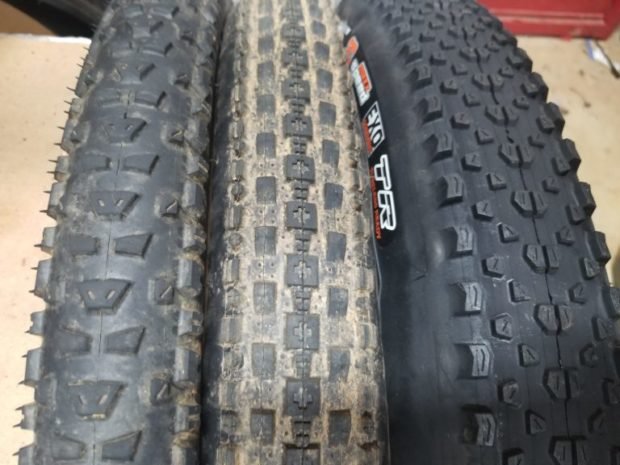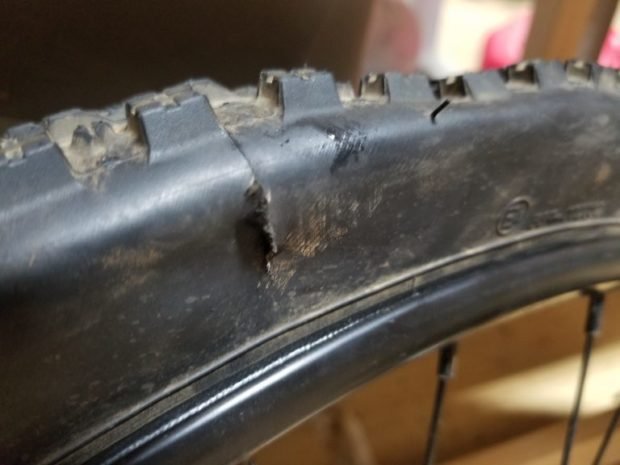Mountain Biking at 50: Tires, Rims and Tape – Oh My
If you’re new to mountain biking, you’re likely overwhelmed by the myriad of options, upgrades, accessories and more. It’s nearly impossible to figure out what matters and what doesn’t as Youtube influencers pedal their sponsors’ wares and magazines publish articles flattering their advertisers’ goods.
Good news. My only sponsor is Conservative Daily News and they receive exactly $0 from bike makers, bike accessory manufacturers or anyone else associated with the sport of mountain biking. That means that if I tell you I like a product, I do and if I tell you it’s not that great – it’s not.
I can’t speak for all the disciplines, but for cross country and trail riding, I can offer a unique, unbiased look into what matters – and honestly, tires really … freaking … matter.
I used to ride serious downhill in my 20’s. I’m not that guy anymore – mainly because I’m 30 years older. I still enjoy putting rubber on dirt, but jumping huge things and massive drop-offs aren’t in my bucket list. So in trail/XC riding, why do tires matter.
My Cannondale 27.5″ hardtail has now thrown me down rooty, rocky, steep, climby, and narrow trails with a variety of rubber underneath. I learned a lot about the rubber and even more about the other stuff in the wheels.
Sidewalls matter
In cross country (XC), weight matters – a lot. The most expensive place to be heavy is in rotating parts like wheels, gears, tires, tubes, cranks, etc. Rotating mass is exponentially more expensive to overcome than pure bike weight so anything that rotates should get attention first when trying to make your bike lighter, and therefore, faster.
So I went to the extreme for my first tire review. I received a set of Maxxis Crossmark II ultra-lightweight, minimum rolling resistance sneakers for my 27.5 wheels. They came without the EXO sidewall reinforcement which keeps these tires ultralight and I wanted to see if they could hold up.

The Crossmarks have an almost solid middle line that does indeed make for lower rolling resistance. The shorter mid and side nubs are adequate at medium speeds but the transition from center to edge nubs was harsh in high-speed turns. As I leaned the bike over I could feel the front slide a bit until the edge nubs caught. Not the feel I was looking for.
Only two rides (about 16 miles of trails) in, and I learned that light sidewalls don’t like rocks.

Without the EXO heavier sidewalls, it was just a week in and this $60 tire had become recyclable.
Not liking how the crossmarks handled in turns, I asked for a set of Maxxis Ikons with the EXO sidewall protection to try.
I received a 27.5×2.35 front tire and 27.5×2.20 rear tire. I prefer my rear wheel to slide first in turns as it might shed a bit of speed, but doesn’t screw up my line. The front tire breaking first means adjusting to a new line or falling off the course.
The IKON’s were just what the doctor ordered. Low rolling resistance, low weight, and the transition from straight to lean-over is smooth and predictable.
I’ve run these tires for three months now (over 400 miles of trails) and sideswiped tons of sharp rocks, cut-off roots and other crap on the trails. No cuts, no flats, no problem. I’m ordering a set for my race bike – like pronto.
Here’s the best way to get some IKONs for your bike.
If you specifically want the 27.5 rubber that I reviewed, that’s available here:
Tread with Caution
I mentioned in the previous section that the Maxxis Crossmark didn’t smoothly transition for me and made me cautious in turns. Looking at the tread pattern shows why that happens.
The Maxxis IKON tires do transition consistently between straight line and hard turns. It may be why this is a very popular CX tire.
Holy Rim Tape Flatman
During my first few months of serious MTB training, I had a series of flats where the puncture was on the rim side of the inner tube. Rim-side flats are usually caused when the tube comes in contact with a spoke hole or metal bur on the rim.
After the first rim-side flat, I looked at the rim tape and found no corresponding punctures and thought that perhaps a rock or other stray bit wandered into the tire and created the hole.
After three straight rim-side flats, I got preventative.

Ritchey rim tapes are not the flimsy rubber crap tapes that show up in bikes. It’s a tough, defensive barrier against rim-side flats.
After running Ritchey tapes for more than 3 months, no rim-side flats. NONE.
Does Rim Width Matter
In a word, maybe. I haven’t been able to do an exhaustive study of rims from 19mm to 30mm. Instead, I have had two wheelsets on my bike and have some information to offer about 19mm vs. 23mm rims.
Oddly, the 19mm rims that came with my bike, WTB Sx19, weren’t terrible, but they did narrow the contact patch for my tires so I requested a set of WTB Frequency Team i23 23mm rims to see if the wider rims would allow my tires to give me more control at speed.
I can honestly say … yes. My favorite local trail has experienced a lengthy period without rain and while that makes it run fast, it also allows a loose layer to form above the hard pack and make for less-confident traction.
With my Ikon 27.5×2.20 rears on 19mm rims, I could feel the back slipping in turns at speeds I didn’t normally worry about.
Once I switched to the WTB i23’s everything changed.
The wider rim width does one thing – it makes the tire profile less round. This puts the middle and edge nubs closer to the ground and puts more rubber on the ground by increasing the contact patch.
The small change in contact patch made those turns a no-brainer as the tire more quickly transitioned to the mid and edge nubs. A slightly wider wheel made those IKONs run even better.
Get yours here:
Find the whole “Mountain Biking at 50 Series HERE“
Content created by Conservative Daily News and some content syndicated through CDN is available for re-publication without charge under the Creative Commons license. Visit our syndication page for details and requirements.




